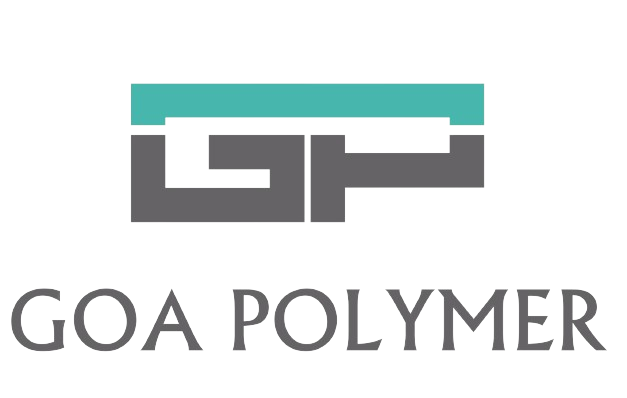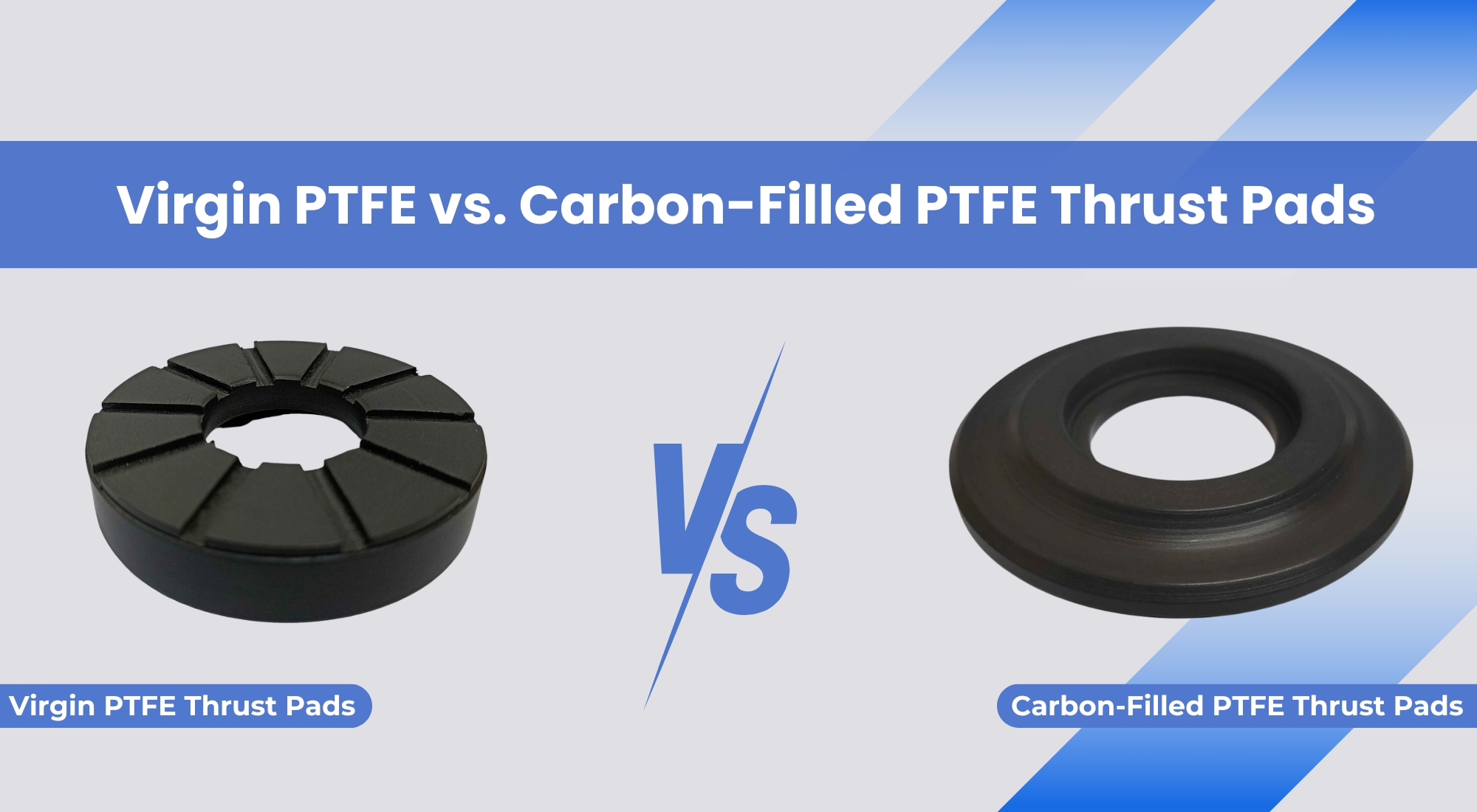One of the most important selection criteria for thrust pads in industrial machines is the type of PTFE used thereon. Being smooth and slippery, and the ability to withstand extremes of temperature and pressure, all these qualities characterize PTFE. But all varieties of PTFE thrust pads are not alike. There are two most popular types: Virgin PTFE and Carbon-Filled PTFE thrust pads. Knowing the difference between these two can help you in picking the right one for your machines.
This blog will analyze the properties of Carbon-Filled PTFE Thrust Pads against those of Virgin PTFE thrust pads, discuss their relative advantages and disadvantages, and help you decide which one meets your needs better.
What are Virgin PTFE Thrust Pads?
Virgin PTFE is made of 100 percent pure Polytetrafluoroethylene (PTFE) without the addition of any fillers like carbon, glass, or bronze. These pads are predominantly used wherever chemical resistance, low friction, and non-reactivity are essential: mostly in food processing equipment, pharmaceutical machinery, and laboratory instruments. A smooth surface in pure PTFE is created, which minimizes the coefficient of friction between the moving parts and helps to prevent any form of buildup or contamination on the material.
However, despite many advantages, Virgin PTFE thrust pads do have a few limitations. They are quite soft and can wear off rather quickly under high pressure or in high-speed applications. Besides, they tend to deform or creep over time when loaded continuously with heavy loads, so they are less suited for uses requiring PTFE for high-load bearing. They offer superior resistance to chemicals and temperature, but do not stand up to mechanical forces in demanding industrial applications. Virgin PTFE thrust pads characteristics are:
- Extremely Low Friction – Ensures smooth operation in moving parts with minimal wear.
- Exceptional Chemical Resistance – Unaffected by most acids, bases, and solvents.
- Superior Electrical Insulation – Ideal for high-performance electronic components.
- Wide Temperature Tolerance – Performs reliably in extreme hot and cold environments.
- Soft & Flexible – Easy to mold, cut, and machine into complex shapes.
- Non-Toxic & FDA-Approved – Safe for use in food, medical, and pharmaceutical applications.
- Durable & Long-Lasting – Maintains integrity even under harsh industrial conditions.
Pure PTFE is soft and tends to wear out quickly when subjected to high pressure or fairly rough conditions.
Application of Virgin PTFE Thrust Pads
- Food Processing Equipment: Use in mixers, conveyors, and sealing machines because Virgin PTFE is FDA-approved, non-toxic, and will not stick or contaminate.
- Pharmaceutical Machinery: Suitably placed in tablet presses, fillers, and blenders to provide clean, chemical-resistant surfaces that satisfy hygiene standards.
- Electronics and Electrical Insulation: Applied to electrical boards and connectors thanks to their excellent insulation and heat-resistant properties.
- Valve Seats and Seals: Smooth movement and tight sealing in low-pressure valves where purity and chemical resistance are key.
Benefits of Virgin PTFE Thrust Pads
- Excellent for a chemical-resistant and contamination-free environment
- For dry-running operations where no lubrication is required
- Cost-effective for applications needing light-duty and low-friction
- Approved for applications in food-grade and medical-grade machinery
What are Carbon-Filled PTFE Thrust Pads?
Carbon-filled PTFE is one sort of Polytetrafluoroethylene that has been reinforced with minuscule carbon particles to increase its mechanical strength, wear resistance, and heat dissipation. While the Virgin PTFE is soft and chemically pure, Carbon-Filled PTFE Thrust Pads is a composite substance engineered for rugged, high-end industrial applications.
By having carbon additives, such as PTFE, offers better durability, especially in settings where loads are heavy and speeds are high. This type of PTFE finds wide application in thrust pads, bearings, seals, and valve parts in machines that operate continuously or under heavy pressure. It is a tradeoff between the low friction of PTFE and the strength and stability given by carbon.
In other words, the presence of carbon reduces the ability of this plastic to resist chemicals and electrically insulate-it doesn’t quite make the grade as pure PTFE would. Also, due to the presence of fillers, it is considered unsuitable for any food or medical applications. Key characteristics of Carbon-Filled PTFE:
- Resistance: Wear resistance is suitable for long-lasting moving parts.
- Compressive Strength: Improved strength resists deformation under pressure.
- Thermal Conductivity: Heat dissipates well with good thermal conductivity.
- Chemical Resistance: Moderate chemical resistance is suitable for most chemicals, but not all.
- Electrical Insulation: Relatively low electrical insulation, so not recommended for high voltage.
Application of Carbon-Filled PTFE Thrust Pads
- Heavy-Duty Industrial Machinery: To be utilized in press machines, gearboxes, and rollers, where PTFE for high-load bearing is needed for long-lasting but reliable support.
- Hydraulic and Pneumatic Systems: Perfectly fit for seals and bearings that are subjected to high pressure and friction without lubrication.
- Valves and Compressors: Functions in all rotating components require wear-resistant thrust pads to provide smooth operations and longer life.
- Chemical Process Equipment: It has resistance to moderate chemical exposure while giving a much better mechanical performance than virgin PTFE thrust pads.
Benefits of Carbon-Filled PTFE Thrust Pads
- The presence of carbon content in PTFE makes its wear-resistant character highly desirable for long-life wear-resistant thrust pads.
- Provides excellent load-bearing capacity of PTFE under heavy machinery.
- Provides better thermal considerations, thus reducing heating during operations.
- Maintains low friction, adding to the strength that allows smooth movement of machines.
- Withstands deformation when pressure is applied, ensuring low-creep behavior and shape stability for a long time.
- Highly suitable for PTFE pads for dry running, which may work efficiently without lubrication.
- Enhances the lifetime of parts, thereby reducing downtime, and improves the life of PTFE thrust pads.
- The carbon-filled PTFE exhibits better action under friction, heat, and load.
PTFE Thrust Pad Comparison: Virgin vs. Carbon-Filled
| Feature | Virgin PTFE | Carbon-Filled PTFE |
| Composition | 100% PTFE | PTFE with carbon filler |
| Friction | Very low | Low |
| Strength | Medium | High |
| Heat Resistance | High | Very high |
| Wear Resistance | Low | High |
| Load Handling | Moderate | Excellent |
| Chemical Resistance | Excellent | Very good |
| Price | Lower | Higher |
Application-Specific Performance (Heat, Pressure, Friction)
Heat Resistance
- The virgin PTFE is capable of resisting heat up to 260 °C.
- The Carbon-Filled PTFE can handle higher temperatures due to carbon’s thermal conductivity.
Pressure Handling
- Virgin PTFE tends to deform under pressure.
- The Carbon-Filled PTFE properties make it apt for high-load bearing uses of PTFE.
Friction and Wear
- Virgin PTFE possesses minimum friction.
- With Carbon-Filled PTFE, the amount of friction increases somewhat, but the wear resistance gets much better.
Conclusion
Choosing between Carbon-Filled PTFE and Virgin PTFE thrust pads depends on what you need. The outcome is contingent upon your specific application. Carbon-filled PTFE pads are great for heavy-duty machines. They have high load-bearing strength and resist wear. Also, they work well in dry-running conditions and offer strong thermal resistance. For clean, non-reactive uses like food or pharma, Virgin PTFE is the best choice.
It offers pure PTFE with strong chemical resistance. Knowing about PTFE thrust pad materials helps you choose wisely for both performance and cost. Reinforced PTFE and pure PTFE have different strengths. Each grade shows unique benefits in the comparison of PTFE thrust pads. Choosing the right PTFE grades for thrust applications is crucial. Consider load, speed, and environmental conditions. This way, your machinery performs better and lasts longer.
Frequently Asked Questions
Not desirable. Virgin PTFE may tend to deform. For high pressure, Carbon-filled PTFE properties offer a better performance.
Yes, but they last longer and perform better in severe environments.
Both are applicable, but Carbon-Filled PTFE would be the choice for high-speed running or loading conditions.
Yes, it is FDA-approved for food contact applications.



